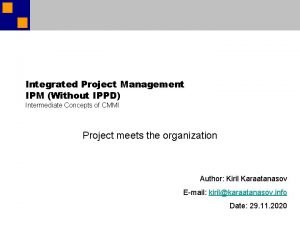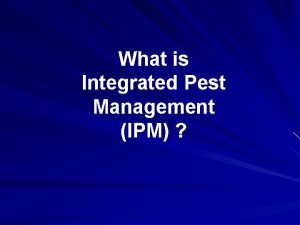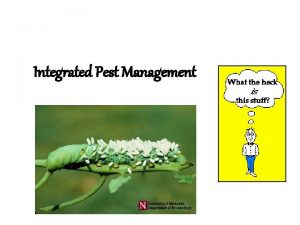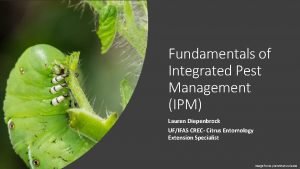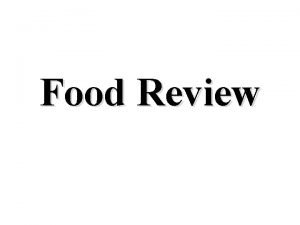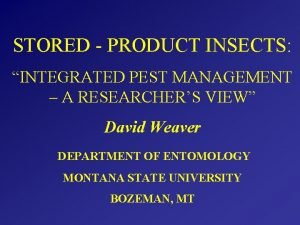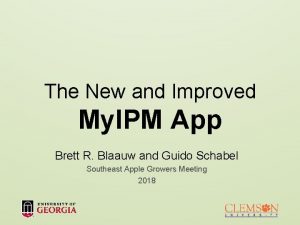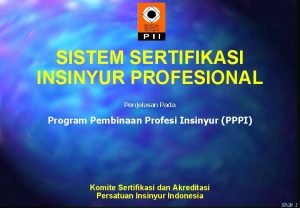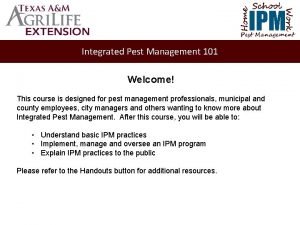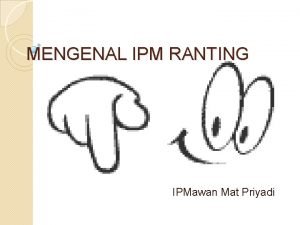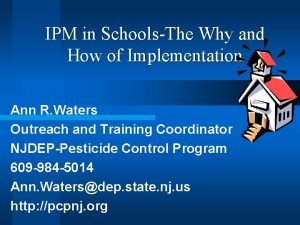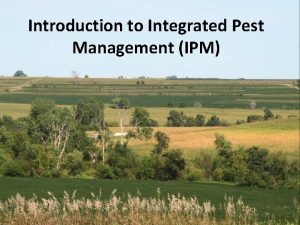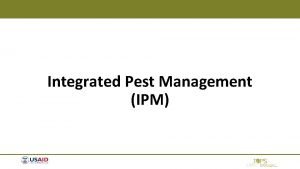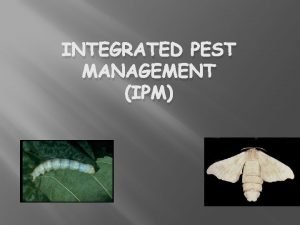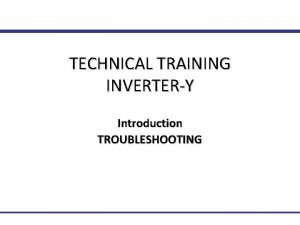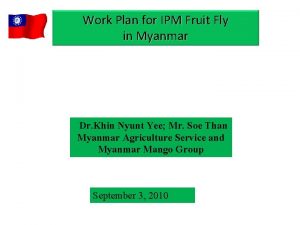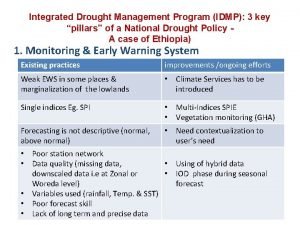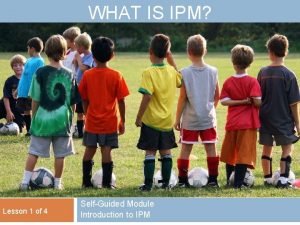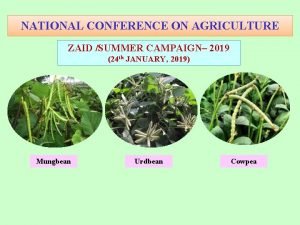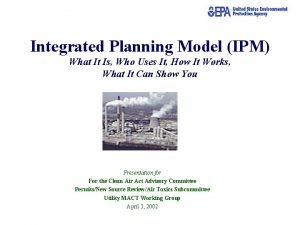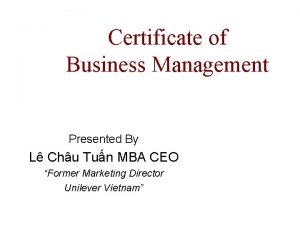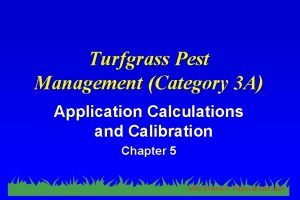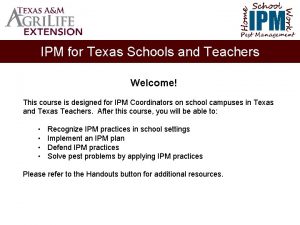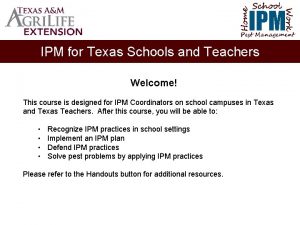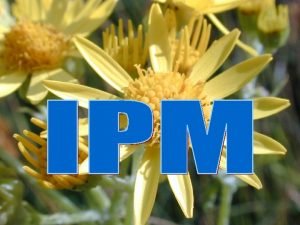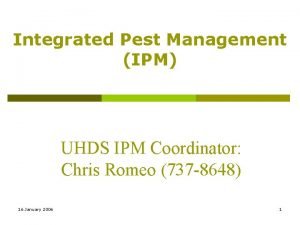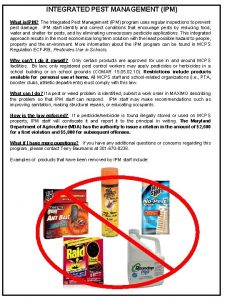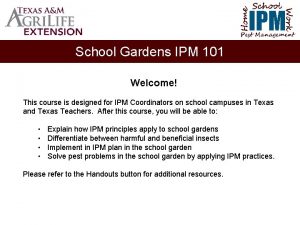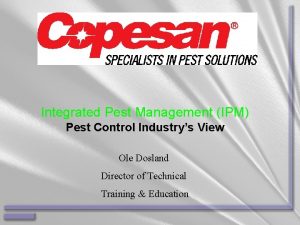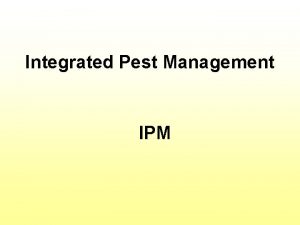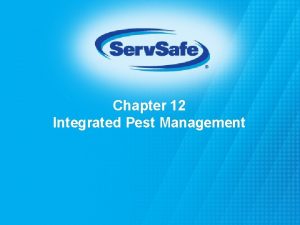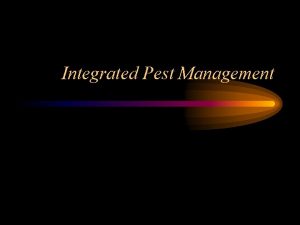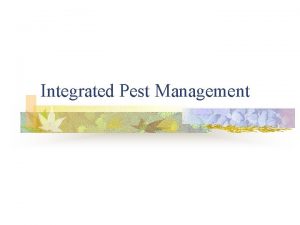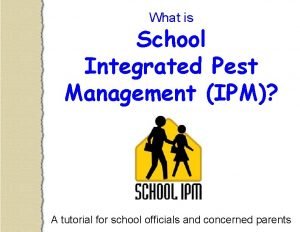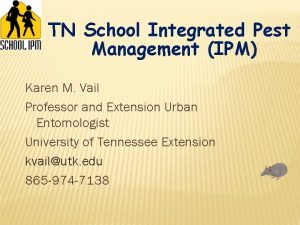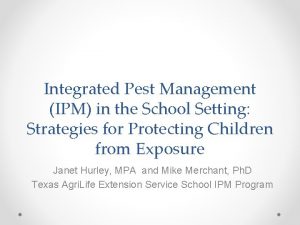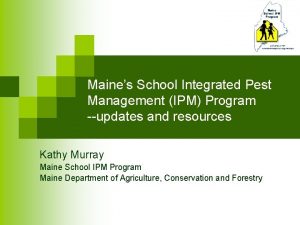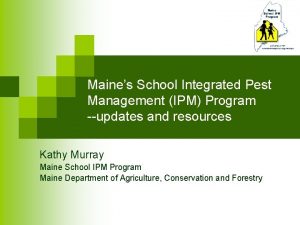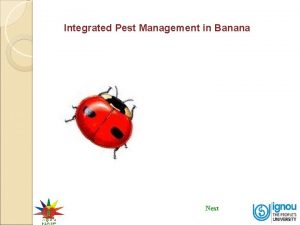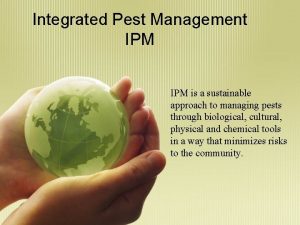School Home Work IPM Pest Management Integrated Pest


































- Slides: 34

School Home Work IPM Pest Management Integrated Pest Management 101 Welcome! This course is designed for pest management professionals, municipal and county employees, city managers and others wanting to know more about Integrated Pest Management. After this course, you will be able to: • Understand basic IPM practices • Implement, manage and oversee an IPM program • Explain IPM practices to the public Please refer to the Handouts button for additional resources.

School Home Work IPM Pest Management Integrated Pest Management 101 What is Integrated Pest Management (IPM)? • IPM is the best pest control with the least environmental impact. • IPM is a proven pest control method that provides long term management, not just a temporary fix. • IPM reduces pesticide exposure to children while safely controlling pests. • IPM can reduce pest complaints by as much as 93%.

School Home Work IPM Pest Management Integrated Pest Management 101 IPM Practices IPM uses a combination of approaches to achieve maximum results when used together: – Prevention – Monitoring – Identification – Maintenance – Recordkeeping – Clean-building practices

Pre-quiz space holder

School Home Work IPM Pest Management Integrated Pest Management 101 IPM varies by context Agricultural, Lawn & Garden Structural IPM Practiced in landscapes, Practiced in and around gardens, farm & ranch land. structures, homes & buildings. Focus is on outdoor pests that diminish the beauty or productivity of landscapes, crops & livestock. Focus is on indoor pests that present problems for people, pets and the structures themselves.

School Home Work IPM Pest Management Integrated Pest Management 101 IPM control strategies different in context IPM Control Strategies Agriculture, Lawn & Garden Structural Biological Control ü Cultural Control (mechanical) ü ü Cultural Control (physical) ü ü Chemical Control ü ü Plant/Host Defenses ü There are fewer IPM control strategies for structural applications. You will begin to understand why as we explore IPM control measures further.

School Home Work IPM Pest Management Integrated Pest Management 101 IPM practices different in each context Why do some specialists think that biological control is not necessary in an urban structural setting? Would YOU release parasitic wasps into an apartment building downtown to control a roach infestation? That might be scary for residents, and it would be impractical. You’re right, but if a garden had an outbreak of aphids, you would certainly want to release ladybug larvae to help you control the aphids.

School Home Work IPM Pest Management Integrated Pest Management 101 IPM Strategy Tree

School Home Work IPM Pest Management Integrated Pest Management 101 We Will Focus On

School Home Work IPM Pest Management Integrated Pest Management 101 More on Biological Control

School Home Work IPM Pest Management Integrated Pest Management 101 Foundations of Biological Control: Two Main Tactics Cause pest’s natural enemies to thrive Make environment less suitable for pest In both situations, the result is the same: Pest populations decline

School Home Work IPM Pest Management Integrated Pest Management 101 Classical Biological Control Releasing the natural ENEMIES from the same region as the pest. Hope the population of the natural enemy establishes in the environment to achieve long term control. Read about effectively controlling Saltcedar with the Saltcedar Leaf beetle in the Texas Panhandle here.

School Home Work IPM Pest Management Integrated Pest Management 101 Many vectors used for biological control Predators Parasitoids Pathogens Bacteria Viruses Fungi Nematodes

School Home Work IPM Pest Management Integrated Pest Management 101 Biological Control: Augmentation Introduces a natural enemy without the hopes of the population establishing in the environment. • Inoculation – Releasing natural enemies before pest is established. • Inundation – Flooding the area with multiple releases of a natural enemy after pest is established. Read about how Trichogramma wasps can successfully control cotton pests using augmentation.

School Home Work IPM Pest Management Integrated Pest Management 101 Conservation Biological Control Protection and encouragement of existing populations of natural pest enemies. Selecting less toxic products will promote populations of beneficial insects. • Do not confuse this with cultural control Read more about biological control.

School Home Work IPM Pest Management Integrated Pest Management 101 Cultural Control Manipulating the surroundings or environment to be less suitable for the PEST population. Keeping pests away from sources of food, water and shelter are the best way to avoid pest problems.

School Home Work IPM Pest Management Integrated Pest Management 101 Physical Cultural Control Keeping pests out and away (sealing holes, screens, sanitation) Sanitation is an effective method of cultural control. Read about controlling houseflies with cultural control methods.

School Home Work IPM Pest Management Integrated Pest Management 101 Mechanical Cultural Control Non-chemical trapping methods and tactics that directly affect the pest population (tillage, fire, sticky traps) The right traps can provide effective control in buildings and homes. Read about mechanical control in gardens. Read about mechanical control in landscapes.

School Home Work IPM Pest Management Integrated Pest Management 101 Chemical Control - Last Resort • Should be the least utilized form of control. • Handle pest problems using biological or cultural control first. • Chemicals should be applied in the least lethal dosage.

School Home Work IPM Pest Management Integrated Pest Management 101 Chemical Control - History • Chemical era (1939 -1962) • DDT (Insecticidal action discovered in 1939) – Heavily used in the United States for agricultural purposes as an insecticide – Banned from usage in the United States in 1972 • Insecticides are an 8 million dollar industry – Many chemicals are applied without proper knowledge of application protocol

School Home Work IPM Pest Management Integrated Pest Management 101 Chemicals have Consequences • Resistance – herbicide and pesticide resistance reported • Secondary Pests – chemicals can upset natural ecological balance • Killing Natural Enemies – IPM promotes natural predator-prey relationships to keep pests at bay • Human Health (teratogenic, mutagenic, carcinogenic) • Environmental Factors – runoff upsets downstream ecology

School Home Work IPM Pest Management Integrated Pest Management 101 Minimize Chemical Exposure 3 million workers are poisoned each year by chemical exposure 20, 000 deaths occur each year Read about risks associated with chemical exposure.

School Home Work IPM Pest Management Integrated Pest Management 101 So, I have a pest problem. What do I do? • Identification: You need to know what pest you are dealing with. • Key things such as: – Morphology – Lifespan – Food Sources – Habitat

School Home Work IPM Pest Management Integrated Pest Management 101 Why Identify? It is crucial that we take steps to reduce chemical usage and exposure. This is why IPM practices have been implemented for decades now. Depending on the type of insect, chemical options may be a waste of time and money! Choose a specific treatment for the behavior, life cycle and location of your specific pest to get the best results.

School Home Work IPM Pest Management Integrated Pest Management 101 Why not use chemicals? For example: • Some pesticides are useless against pests that have piercing/sucking mouthparts • They will only kill the insect if the chemical directly touches the body.

School Home Work IPM Pest Management Integrated Pest Management 101 Pesticide application rules Safe use of pesticides involves several checkpoints: • Post notice in areas where pesticides will be applied • Heed re-entry periods • Use only licensed applicators • Mixing should occur outside occupied areas • Non-pesticide measures need no posting • Manage pesticide drift • Heed rules relating to pesticide categories

School Home Work IPM Pest Management Integrated Pest Management 101 IPM works by a series of steps: Pesticides Biological controls Physical / Mechanical controls Pest prevention & Sanitation

School Home Work IPM Pest Management Integrated Pest Management 101 First line of defense: Prevent & clean up Pest prevention & sanitation are the two primary building blocks of an IPM program. • Clean the area thoroughly. • Get rid of clutter. • Eliminate messy storage, cardboard boxes and needless stacks of paper. • Investigate alternate records retention methods to reduce paper storage. Sanitation can dramatically reduce pest claims.

School Home Work IPM Pest Management Integrated Pest Management 101 Second line of defense: Physical & Mechanical Physical controls involve sealing pest entrances. Examples of mechanical controls include traps and fences for gardens. • Observe where pests come and go. • Caulk or seal openings where pests enter. • Strategically place traps.

School Home Work IPM Pest Management Integrated Pest Management 101 Third line of defense: Biological controls As we have discussed, Biological controls mean you are using one creature to control another creature. • Understand relationships between predator and prey • Take advantage of beneficial insects • Realize that pesticides kill both beneficial and harmful insects equally.

School Home Work IPM Pest Management Integrated Pest Management 101 Final line of defense: Pesticide Use Judicious use of pesticides is sometimes warranted after all other measures have been unsuccessful. Use the least toxic pesticide that will get the best results for the target pest.

School Home Work IPM Pest Management Integrated Pest Management 101 Types of IPM Applications Minimizes pest management risks IPM Process Pest Prevention Communication Common sense sanitation and maintenance steps minimize food, water and shelter pests need to thrive. Everyone plays a role in IPM – they must know how to do their part.

School Home Work IPM Pest Management IPM Basics Quiz and Certificate Please complete the quiz and print your certificate of completion. Please complete a course evaluation at this link. <LINK> Your feedback will be used to improve the course for future learners!

Blank to insert quiz in spreadsheet
 Cmmi ipm
Cmmi ipm Pest management learning
Pest management learning Integrated pest management
Integrated pest management Ipm
Ipm Integrated pest management ____ than pesticides.
Integrated pest management ____ than pesticides. What is the third step in integrated pest management?
What is the third step in integrated pest management? My ipm
My ipm Program profesi insinyur
Program profesi insinyur Ipm
Ipm Ipm adalah
Ipm adalah What is an ipm plan
What is an ipm plan Ipm meaning
Ipm meaning Ipm
Ipm Ipc pest control
Ipc pest control Ipm error/ igbt error daikin
Ipm error/ igbt error daikin Ipm myanmar
Ipm myanmar Pillars of ipm
Pillars of ipm Ipm grade 1
Ipm grade 1 Ipm indeks pembangunan manusia
Ipm indeks pembangunan manusia Ipm 410-3 (shikha) price
Ipm 410-3 (shikha) price Integrated planning model
Integrated planning model Pipe onion
Pipe onion Ipm tuyển dụng
Ipm tuyển dụng Apa arti home care
Apa arti home care Perbedaan home care dan home visit
Perbedaan home care dan home visit Homes for sale in roebuck sc
Homes for sale in roebuck sc Plurals of flower
Plurals of flower Come home come home jesus is calling
Come home come home jesus is calling Oak springs mobile home park
Oak springs mobile home park Let's go to your house
Let's go to your house Jr rabbin imam pretre
Jr rabbin imam pretre She said that, home economics stands for the ideal home.
She said that, home economics stands for the ideal home. Home sweet home survive items
Home sweet home survive items Turfgrass pest management (category 3a practice test)
Turfgrass pest management (category 3a practice test) Pest management alliance
Pest management alliance
